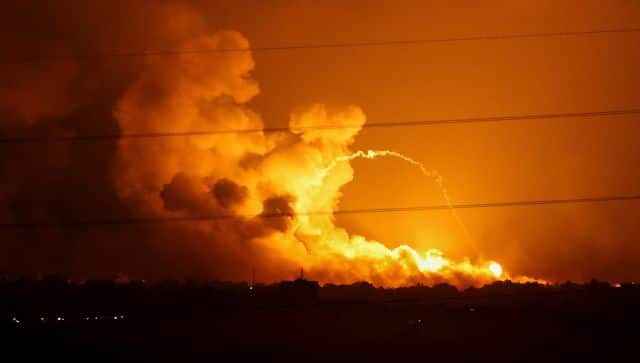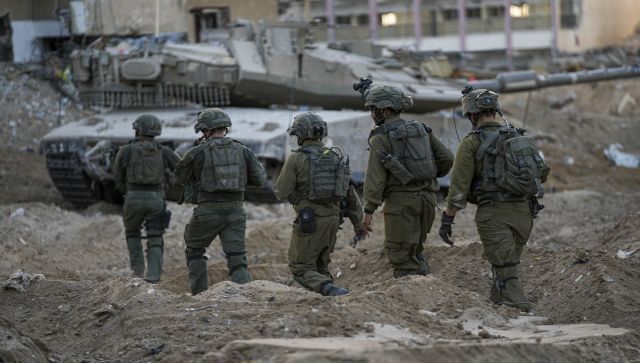When the Israel-Hamas war began, Prime Minister Benjamin Netanyahu vowed to defeat and eliminate the Palestinian militant group. Now a month on as the Jewish nation has intensified its ground and air campaign in the Hamas-controlled Gaza Strip, the plans have become more ambitious. In an interview earlier this week, Netanyahu said that Israel would maintain indefinite "overall security responsibility” in the enclave once it removes Hamas from power. But he didn’t elaborate on what that would look like. If history is taken into consideration, any Israeli security role in Gaza will be seen as a form of military occupation by the Palestinians and a majority of the international community. This could complicate any plans to hand governing responsibility to the Palestinian Authority or friendly Arab states, and risk bogging Israel down in a war of attrition, reports The Associated Press (AP). Even if Israel succeeds in ending Hamas’ 16-year rule in Gaza and destroying much of its militant infrastructure, the presence of Israeli forces is likely to fuel an insurgency, as it did from 1967 to 2005. That period saw two Palestinian uprisings and the rise of Hamas. Israel’s biggest ally, the United States, is aware of the consequences. Hence soon far Netanyahu’s remarks, US secretary of state Antony Blinken said that Israel must not reoccupy Gaza. However, he added that Israel might control the territory for a transition period. Benny Gantz, of Israel’s three-member War Cabinet, also acknowledged Wednesday that there was still no long-term plan for Gaza. He said any plan would have to address Israel’s security needs. “We can come up with any mechanism we think is appropriate, but Hamas will not be part of it,” he told the media. “We need to replace the Hamas regime and ensure security superiority for us.” Amid growing speculation, here’s a look at what a lingering Israeli security role might look like and the opposition it would inevitably generate.
When Israel captured Gaza In the 1967 Mideast War, Israel captured Gaza, the West Bank, and East Jerusalem, territories the Palestinians wanted for a future state. Israel annexed East Jerusalem, home to the Old City and its sensitive religious sites — a move not recognised by the international community — and considers the entire city its capital. The military directly governed the West Bank and Gaza for decades, denying basic rights to millions of Palestinians. Soldiers staffed checkpoints and carried out regular arrest raids targeting militants and other Palestinians opposed to Israeli rule. [caption id=“attachment_13369962” align=“alignnone” width=“640”] Israeli army troops are seen on the Israeli-Gaza border during a ground operation in the Gaza Strip on 8 November. AP[/caption] Israel also built
Jewish settlements in all three areas. Palestinians and most of the international community consider these settlements illegal. After two decades of outright military rule, Palestinians rose up in the first intifada, or uprising, in the late 1980s. That was also when
Hamas first emerged as a political movement with an armed wing, challenging the secular Palestine Liberation Organization’s leadership of the national struggle. The West Bank way Interim peace deals in the mid-1990s known as the Oslo Accords established the Palestinian Authority as an autonomous government in the West Bank and Gaza meant to lead the way toward an independent Palestinian state alongside Israel. Several peace initiatives by a string of American presidents failed. The Palestinian Authority lost control of Gaza to Hamas in 2007. That has left the Palestinian Authority in charge of roughly 40 per cent of the Israeli-occupied West Bank. Its powers are largely administrative, though it maintains a police force. Israel wields overall security control. [caption id=“attachment_13370002” align=“alignnone” width=“640”]
Palestinians walk through a destroyed street after an Israeli military raid in Tulakrem refugee camp in the West Bank on 7 November. AP[/caption] Palestinian President Mahmoud Abbas is deeply unpopular, in large part because his forces cooperate with Israel on security even as Palestinian hopes for statehood have all but disappeared. Many Palestinians view the PA as the subcontractor of a never-ending occupation. Israel keeps tens of thousands of soldiers deployed across the West Bank. They provide security for more than 500,000 Jewish settlers and carry out nightly arrest raids, often sparking deadly gunbattles with militants. US Secretary of State Antony Blinken has suggested the Palestinian Authority could return to Gaza after the war. That could further unravel Abbas’ legitimacy among his own people unless it were linked to concrete steps toward Palestinian statehood. Arab leaders, even those closely tied to Israel, will likely face similar backlash if they step in to help it control Gaza. Also read: Will handle Gaza for 'indefinite period', says Netanyahu. Will it go West Bank way? The Gaza model What about an over-the-horizon presence, with moderate Palestinians maintaining security inside Gaza and with Israel intervening only when it deems it absolutely necessary? In 2005, in the wake of a second and far more violent intifada, Israel withdrew soldiers and over 8,000 settlers from
Gaza . The PA administered the territory, but Israel continued to control its airspace, coastline, and all but one border crossing. Hamas won Palestinian elections the next year, leading to an international boycott and a severe financial crisis. Months of unrest boiled over in June 2007, when Hamas drove out forces loyal to Abbas in a week of street battles. [caption id=“attachment_13370022” align=“alignnone” width=“640”]
Palestinians flee Gaza City to the southern Gaza Strip on Salah al-Din Street in Bureij, on 7 November. AP[/caption] Israel and Egypt imposed a blockade on Gaza, severely restricting trade and travel in what Israel said was an effort to contain Hamas. Palestinians and rights groups considered it a form of collective punishment. It caused widespread misery among the enclave’s 2.3 million residents. Israel, like most Western countries, considers Hamas a terrorist organisation. Hamas has never recognised Israel’s existence and is committed to its destruction through armed struggle. But over 16 years that saw four wars, the two entered into various undeclared ceasefires in which Israel eased the blockade in return for Hamas halting rocket attacks and reining in more radical armed groups. For Israel, the arrangement was far from ideal but preferable to other options and bought yearslong periods of relative calm. Lessons from Lebanon In 1978 and then again in 1982, Israel invaded southern Lebanon in a battle against Palestinian militants. That led to an 18-year occupation enforced through the local ally the South Lebanon Army (SLA), which received arms and training from Israel. In 1982, the Lebanese militant group Hezbollah was founded with Iranian backing with the objective of pushing Israeli forces out of the country. It carried out attacks on both the SLA (SLA) and Israeli troops, eventually leading to Israel’s withdrawal in 2000. The SLA quickly collapsed, creating a vacuum that was filled by Hezbollah. In 2006, the group battled Israel to a stalemate during a monthlong war. Today,
Hezbollah is the most powerful force in Lebanon. With an estimated 150,000 rockets and missiles, it’s considered a major threat by Israel. [caption id=“attachment_13370082” align=“alignnone” width=“640”]
Black smoke rises from an Israeli airstrike on the outskirts of Aita al-Shaab, a Lebanese border village with Israel in south Lebanon on 4 November. The Lebanon-Israel border has been the site of regular clashes between Israeli forces on one side and Hezbollah and Palestinian armed groups on the other since the beginning of the Israel-Hamas war. AP[/caption] Is there any other option? Israel has sent mixed messages about evolving plans for Gaza. Leaders say they don’t want to reoccupy Gaza. They also say troops need freedom to operate inside Gaza long after heavy fighting subsides. “On the question of the operation’s length – there are no limitations,” Gantz said Wednesday. That could mean leaving troops stationed inside the territory or along the border. Some officials have discussed a buffer zone to keep Palestinians away from the border. Others, including the US, have called for the Palestinian Authority’s return. [caption id=“attachment_13370102” align=“alignnone” width=“640”]
 Smoke and flames rise during Israeli strikes in the Gaza Strip, as seen from the Israeli side of the border with Gaza, in southern Israel. Reuters[/caption] In another twist, Gantz suggested any future arrangement for Gaza be contingent on calming Israel’s northern front with Hezbollah and the West Bank, where troops regularly battle Palestinian militants. “Once the Gaza area is safe, and the northern area will be safe, and the Judea and Samaria region will calm down – we will settle down and review an alternative mechanism for Gaza,” said Gantz, using the biblical term for the West Bank. “I do not know what it will be.” The future of Gaza and that of its residents remains uncertain. With inputs from AP
Smoke and flames rise during Israeli strikes in the Gaza Strip, as seen from the Israeli side of the border with Gaza, in southern Israel. Reuters[/caption] In another twist, Gantz suggested any future arrangement for Gaza be contingent on calming Israel’s northern front with Hezbollah and the West Bank, where troops regularly battle Palestinian militants. “Once the Gaza area is safe, and the northern area will be safe, and the Judea and Samaria region will calm down – we will settle down and review an alternative mechanism for Gaza,” said Gantz, using the biblical term for the West Bank. “I do not know what it will be.” The future of Gaza and that of its residents remains uncertain. With inputs from AP


)

)
)
)
)
)
)
)
)



